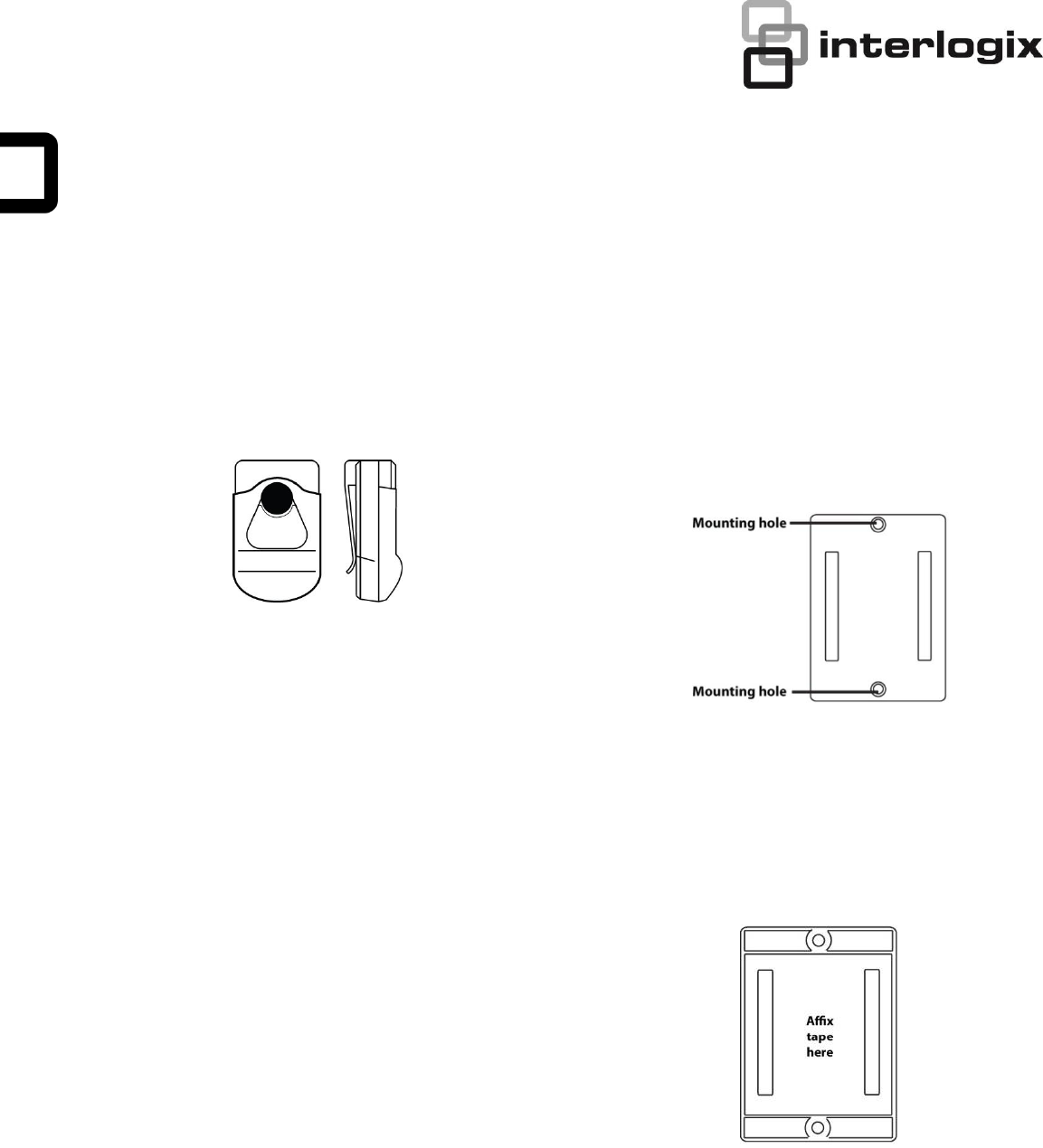UTC Fire and Security Americas 697B1-PANIC 60-578 User Manual 9 XXX Model Name Installation Sheet
UTC Fire & Security Americas Corporation, Inc. 60-578 9 XXX Model Name Installation Sheet
User Manual

© DDMONYY UTC Fire & Security. All rights reserved. 1 / 2 P/N 46-667 • REV K • 7MAY18
Learn Mode Water Resistant Pendant Panic
Button Installation Instruction
Product Summary
The 60-578 Panic Button can be used throughout the
premises for police, medical or auxiliary alarm activation.
When the sensor button is pressed, the built-in transmitter
sends a signal to the panel (see Figure 1).
Figure 1: 60-578 Pendant Panic Button
The water-resistant design helps prevent damage in case
the sensor accidently gets wet.
The sensor can be worn using the built-in belt clip or it can
be mounted on a wall in a location convenient for the
customer, using the optional wall-mount holder (kit number
80-116). Each kit includes the following:
(5) wall-mount holders
(5) pieces of double-sided tape
(10) plastic anchors
(10) Phillips-head screws
You will also need a small Phillips screwdriver (if installing
the optional wall-mount holder).
Installation Guidelines
Use the following guidelines when installing this button:
The transmitter in the button has an open-air range of
up to 1,000 ft. (305 m), but the installation environment
may influence this range.
When mounting on a wall, determine the best location
for each panic button so it is easily accessible.
The 3.5 VDC lithium batteries will last at least 12
months.
Installation
You can mount the optional wall-mount holder, using
anchors and screws or double-sided tape.
To mount the holder with anchors and screws:
1. Place the holder on the wall at the desired location and
mark the mounting holes with a pencil (Figure 2 below).
Figure 2: Mounting with screws
2. Secure the holder to the wall with the screws supplied.
Use the anchors supplied where studs are not present.
To mount the holder with double-sided tape:
1. Peel off the colored backing from the double-sided tape
and place it on back of the holder (Figure 3 below).
Figure 3: Mounting with double-sided tape
2. Peel off the other backing and firmly press the holder
against the mounting surface.

2 / 2 P/N 46-667 • REV K • 27APRIL18
Programming
This section describes the basic steps for adding the sensor
to panel memory. For complete instructions, refer to the
specific panel’s documentation.
To program the sensor:
1. Set the panel in program mode.
2. When prompted by the panel, enter the appropriate
group number (groups 00 through 07).
Note: For UL installations where the holder is used, the
sensor must be added as a fixed type (sensor groups
00, 02, 04, or 05).
3. When prompted by the panel, select the desired sensor
number.
4. When prompted by the panel, trip the sensor by
pressing the sensor button.
5. Exit from program mode.
Sensor Test
To test the sensor:
1. Set the system to the Dealer Sensor Test mode.
2. Press the button on the sensor.
3. Count the number of signals received by the panel,
indicated by interior siren beeps. Seven to eight beeps
are considered acceptable.
4. Test the sensor from several locations within the
premises to check for consistent response.
Battery Replacement
To replace the sensor battery:
1. To disassemble the sensor, remove the two screws on
the back of the sensor and separate the front and back
plastic.
Caution: You must be free of static electricity before
handling the transmitter circuit board. Touch a
grounded, bare metal surface before touching the
circuit board, or wear a grounding strap.
2. Remove the old battery from its holder and install the
new battery, observing polarity.
Caution: Install only the same size and type of battery. Do
not substitute another size or type of battery.
3. Reassemble the sensor.
Note: Be sure to assemble the sensor correctly to ensure
water resistance. Be especially careful not to nick or
damage the rubber gasket lining.
4. Test the sensor as described in “Sensor Test” above.
Lithium Battery Disposal
Lithium batteries that are no longer usable are considered
hazardous waste. Be sure to properly dispose of the old
battery. Contact your local city government for hazardous
waste disposal laws.
Specifications
Compatibility
All Interlogix Security Learn Mode panels
Power source
3.6 VDC Saft or Tekcell lithium battery
Enclosure
Water-resistant and shock-resistant
Dimensions (LxWxD)
2.25" x 1.75" x 0.75" (57.1 mm x 44.4 mm x
19 mm)
Regulatory Information
Manufacturer
UTC Fire & Security Americas Corporation, Inc.
2995 Red Hill Ave, Costa Mesa, CA 92626 USA
FCC / IC
compliance
This device complies with part 15 of the FCC
Rules. Operation is subject to the following two
conditions: (1) This device may not cause harmful
interference, and (2) this device must accept any
interference received, including interference that
may cause undesired operation.
Changes or modifications not expressly approved
by Interlogix can void the user’s authority to
operate the equipment.
FCC ID: B4Z-697B1-PANIC
IC ID: 1175C-697B1PANIC
This device complies with Industry Canada
license-exempt RSS standard(s). Operation is
subject to the following two conditions: (1) this
device may not cause interference, and (2) this
device must accept any interference, including
interference that may cause undesired operation
of the device.
Cet appareil est conforme aux normes RSS
exemptes de licence d'Industrie Canada.
Le fonctionnement est soumis aux deux
conditions suivantes : (1) cet appareil peut ne pas
provoquer d’interférences et (2) cet appareil doit
accepter toutes interférences, y compris les
interférences pouvant provoquer un
fonctionnement non désiré de l’appareil.
U.S. patents
4,855,713, 4,864,636, and others pending.
Contact information
www.utcfireandsecurity.com or www.interlogix.com
For customer support, see www.interlogix.com/customer-support
© 2018 UTC Fire & Security Americas Corporation, Inc.
Interlogix is part of UTC Climate Controls & Security, a unit
of United Technologies Corporation. All rights reserved.
May 7, 2018